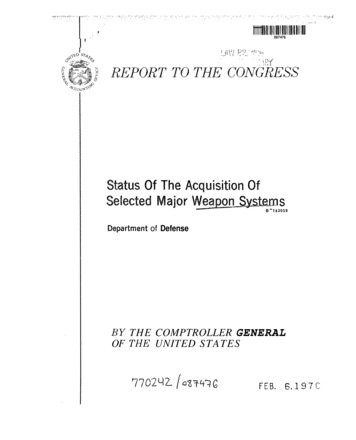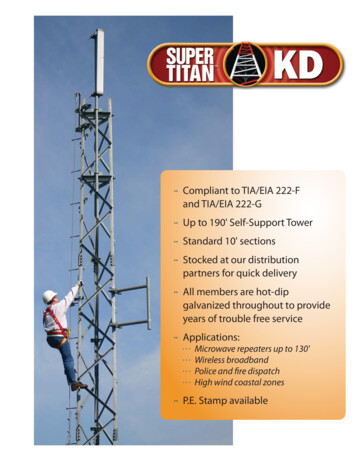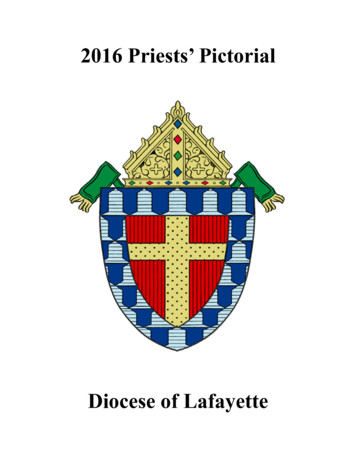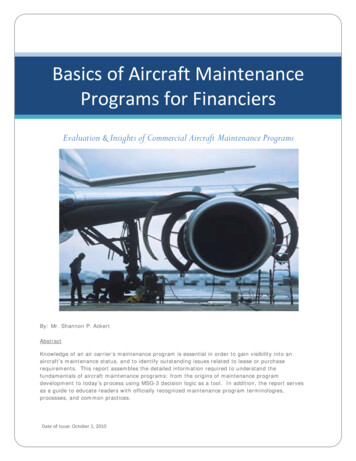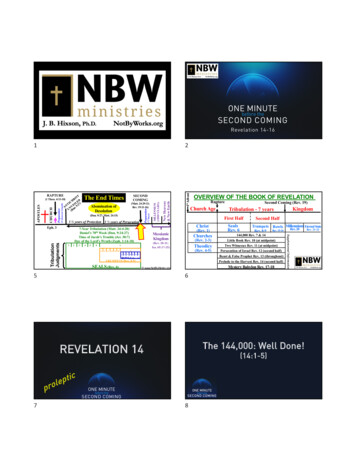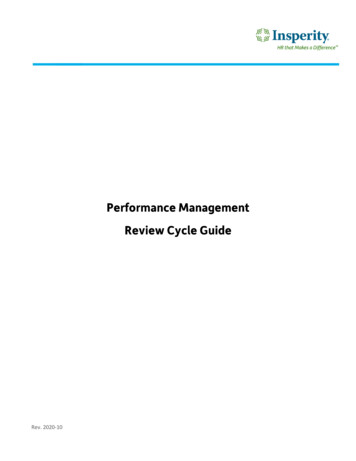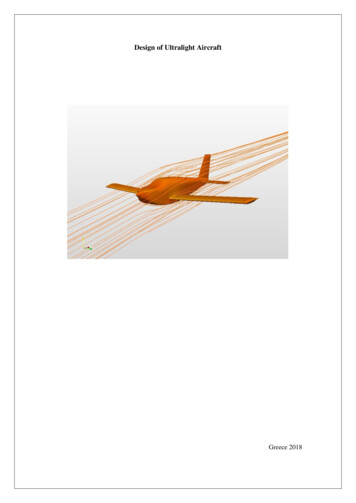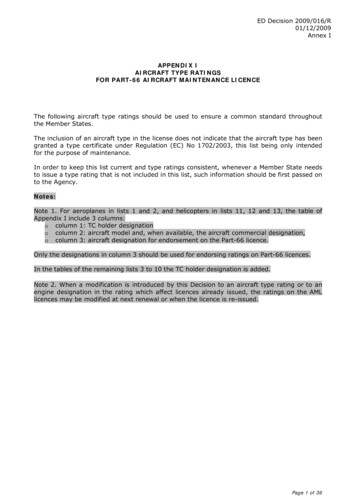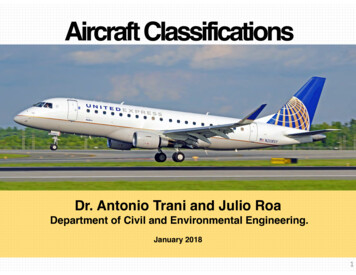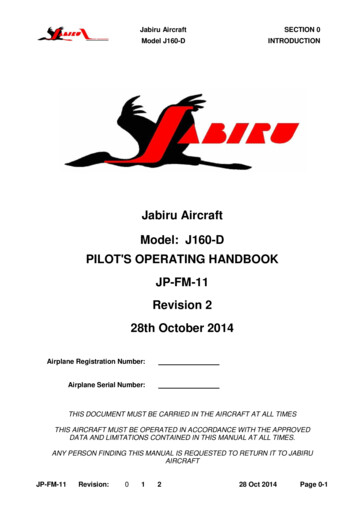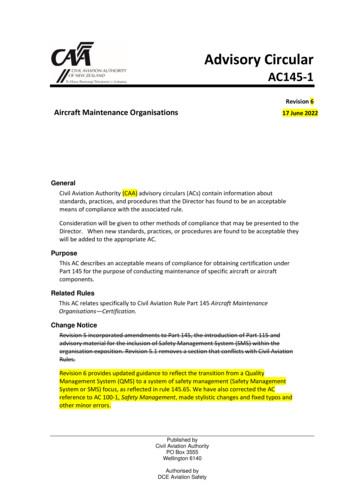
Transcription
Advisory CircularAC145-1Revision 6Aircraft Maintenance Organisations17 June 2022GeneralCivil Aviation Authority (CAA) advisory circulars (ACs) contain information aboutstandards, practices, and procedures that the Director has found to be an acceptablemeans of compliance with the associated rule.Consideration will be given to other methods of compliance that may be presented to theDirector. When new standards, practices, or procedures are found to be acceptable theywill be added to the appropriate AC.PurposeThis AC describes an acceptable means of compliance for obtaining certification underPart 145 for the purpose of conducting maintenance of specific aircraft or aircraftcomponents.Related RulesThis AC relates specifically to Civil Aviation Rule Part 145 Aircraft MaintenanceOrganisations—Certification.Change NoticeRevision 5 incorporated amendments to Part 145, the introduction of Part 115 andadvisory material for the inclusion of Safety Management System (SMS) within theorganisation exposition. Revision 5.1 removes a section that conflicts with Civil AviationRules.Revision 6 provides updated guidance to reflect the transition from a QualityManagement System (QMS) to a system of safety management (Safety ManagementSystem or SMS) focus, as reflected in rule 145.65. We have also corrected the ACreference to AC 100-1, Safety Management, made stylistic changes and fixed typos andother minor errors.Published byCivil Aviation AuthorityPO Box 3555Wellington 6140Authorised byDCE Aviation Safety
Throughout, we have substituted guidance on quality management with reference toAC100-1, as participants are advised to follow this AC when designing their SMS. Lastly,we have taken the opportunity to add a Version History.Note: The rules related to Quality Assurance and QMS expired in February 2021 and werereplaced with SMS requirements in rule 145.65.Version HistoryHistory Log (Revision No.Effective DateSummary of ChangesAC145-01, Rev 017 Aug 1994Initial issue of this ACAC145-1A25 Dec 1997Changes not specifiedAC145-1, Rev 1A21 Jan 2005Amended and corrected two wording errors in 145.60AC145-1, Rev 327 April 2007Re-numbered this AC from AC 145-1A to AC 145-1 aspart of a project to standardise numbering of all ACs.AC145-1, Rev 424 July 2007Corrected various references to other ACs which havenow been re-numbered.AC145-1, Rev 51 May 2015General revision. Incorporated recent rule amendmentsto Part 145, the introduction of Part 115 and advisorymaterial for the inclusion of Safety ManagementSystem (SMS) within the organisation exposition.AC145-1, Rev 5.19 April 2021Incorporated amendments to Part 145, the introductionof Part 115 and advisory material for the inclusion ofSafety Management System (SMS) within theorganisation exposition.Removed section that conflicts with Civil Aviation Rules.AC145-1, Rev 617 June 2022Updates guidance to reflect the change from aQMS to an SMS focus.Makes changes throughout to reflect the update ofrule 145.65 to being about the need for an SMS.Updates references to AC 100-1, SafetyManagement.Makes stylistic changes and corrects typos andother minor errors throughout.Substitutes guidance on quality management withreference to AC100-1.Takes the opportunity to add a Version History.
Advisory CircularAC145-1Revision 6Table of ContentsSubpart A – General . 3145.1 Applicability . 3145.5 Requirement for certificate . 3145.7 Application for certificate . 3145.9 Issue of certificate . 3145.11 Privileges of certificate holder . 4145.13 Duration of certificate. 4145.15 Notification of ceasing maintenance . 5145.17 Renewal of certificate . 5Subpart B – Certification Requirements. 7145.51 Personnel requirements . 7145.52 Maintenance personnel duty time limitations . 11145.53 Facility requirements . 11145.55 Equipment, tools and materials . 14145.57 Reserved . 15145.59 Maintenance control procedures . 15145.60 Authorisation procedures . 19145.61 Continued airworthiness . 22145.63 Records . 23145.65 Internal quality assurance Safety management . 26Relationship between SMS and QMS . 26145.67 Aircraft Maintenance Organisation (AMO) exposition . 27Subpart C — Operating Requirements . 31145.101Continued compliance . 31145.103Privileges and limitations of authorisation holders . 31145.105Changes to certificate holder’s organisation . 31Appendix A: Organisation Exposition . 33General. 33Front matter . 33Exposition revision control . 33Abbreviations, acronyms and definitions . 33Section 1 –AMO maintenance organisation management . 34Section 2 - Maintenance procedures. 38Section L2 - Additional line maintenance procedures . 41Section 3: Quality and Safety Management . 42Quality management systems . 42Quality audit of organisation procedures . 42Quality audit of aircraft / equipment / components (aeronauticalproducts) . 42Quality audit remedial action procedure . 42Section 4 – Authorisations Operations . 42Section 5 4 - Operations . 44Section 6 5 - Training and assessment (E1 rating or internal training). 44317 June 2022CAA of NZ
Advisory CircularAC145-1Revision 6Section 7 6 - Appendices. 45Appendix B. 47Appendix B: Sub-contracting (extension of quality system to a noncertified organisation). 48Introduction. 48General conditions. 48Procedures. 48Appendix C D: Maintenance contracting arrangements . 50Introduction. 50Responsibilities . 50General conditions. 51Detailed content of the maintenance agreement . 51417 June 2022CAA of NZ
Advisory CircularAC145-1Revision 6Subpart A – GeneralTo assist readers with cross-referencing, the numbering of the paragraphs contained within this ACcorresponds with specific rules in the numbering of Part 145.145.1ApplicabilityPart 145 applies to organisations seeking certification as aircraft maintenance organisations (AMOs).Organisations located outside New Zealand will only be certificated if the service they providerequires them to be certificated, such as if they provide maintenance services to a New Zealandoperator or organisation.145.5Requirement for certificateA Part 145 certificate is required when conducting the activities specified in rule 43.54. Aircraft thatare smaller than those in rule 43.54(a) may be maintained by an organisation certificated under Part145 and are provided for under the A4 rating.The specific privileges of the Part 145 certificate holder are detailed under rule 145.11 see below.145.7Application for certificateThis rule prescribes the form to be used by an applicant for the grant of a maintenance organisationcertificate. to be submitted and does not require the applicant to provide any further detailedinformation. The application can then be registered with the Civil Aviation Authority (CAA) andassistance in developing the organisation can be provided against this application. A New Zealandaddress is required for applicants based outside New Zealand; this may be the address of a solicitoror an authorised agent.The applicant should provide the information required by form CAA 24145/01. The form can bedownloaded from the CAA website, www.caa.govt.nz, under “Forms” in the “A to Z ” list. in the QuickLinks column.It is important that all forms and the Part 145 matrix (24145-02), which is also available in the Formssection, are completed correctly as this will save time when processing the application.145.9Issue of certificateThere are several requirements to be met for the issue of the certificate. Primarily, the applicantmust meet the requirements of Part 145 Subpart B of the rule to be issued a certificate. A copy of theCAA’s Certification Policy - Organisations is available on the CAA website at this link. under “A to ZTopics” and “CAA Operational Policies”.To be assessed as meeting the requirements of Subpart B the applicant’s documentation will bechecked for compliance with the rules and suitability for the type of maintenance tasks the applicantis proposing to perform.After the documentation is accepted as satisfactory, CAA will carry out an inspection of theapplicant’s facilities and resources, will be made including interviews with nominated senior persons.This initial comprehensive inspection will ensure that the organisation is capable of complying cancomply with their exposition and that the exposition accurately reflects the organisation’s activities.Once the Director is satisfied that all certification requirements have been completed in asatisfactory manner, the certificate is issued.317 June 2022CAA of NZ
Advisory CircularAC145-1Revision 6145.11 Privileges of certificate holderThe certificate is issued with ratings reflecting the categories level of maintenance the organisation iswill be considered competent to perform.Whilst While the certificate ratings are general, the detailed capability of an organisation should bestated in their exposition. This detailed capability will largely be dependent on the facilities theorganisation has access to, and the experience and qualifications of the personnel the organisationemploys. An applicant should not detail activities the organisation will not be able to provide.Does the organisation require an Aircraft (A) rating or a Component (C) rating?If a component is removed from an aircraft, has maintenance performed on it in accordance withacceptable data and is re-installed on the same aircraft; then, provided that the maintenance iswithin the capability of the Part 145 Aircraft Maintenance Organisations Certification (AMO), it canbe released to service under the privileges of the organisation’s A rating.If a component is removed from an aircraft (or stock), has maintenance performed and then is putinto stock or onto a different aircraft; then the work should be performed under a C rating.The scope of work that can be being performed under the C rating is detailed within the capability listand will take into account the following aspects: the extent of: Facilities Data Tooling Equipment Trained and authorised personnel.The scope should also describe the extent of work that may be performed and may be limited byspecific reference to the Aircraft Maintenance Manual (AMM) or Component Maintenance Manual(CMM) as appropriate.Additional limitations on certificateThe Director may place prescribe limitations and conditions on an AMO maintenance organisationcertificate. These additional limitations placed upon the certificate may include, but are not limitedto, models from a Type Certificate, limitations based on the applicable requirements of Parts 43 and66, or general qualifications of the maintenance activities considered appropriate.145.13 Duration of certificateThe initial certificate can be issued for up to five years, but the maximum duration isn’t alwaysgranted. The length of the initial certificate will be decided on a case-by-case basis. The term of theinitial certificate will be determined on a case-by-case basis but will generally be issued for up to fiveyears. During this period, the organisation may have a spot check conducted after three months, butwill have a comprehensive audit within six months of the issue date, followed by another audit 12months later. The depth of the second and future audits will be determined after assessing theorganisation’s risk profile. Details of this rating process may be found on the CAA web site under‘Risk Profile ratings Ratings’.Subsequent certificates may be issued with a validity of up to five years.417 June 2022CAA of NZ
Advisory CircularAC145-1Revision 6Certificates that which expire, are suspended, or are revoked, must be returned to the CAA.Certificates should be returned to the Director at the ‘Contact Us’ address shown on the CAA websitewithin seven days of their ceasing to be effective.145.15 Notification of ceasing maintenanceIf an organisation decides to cease maintenance services, they are required to notify the CAA inwriting and request revocation of the certificate within 30 days of the date of cessation.As well as ensuring the CAA has an accurate picture of the AMO aircraft maintenance organisationswithin New Zealand and overseas, there are continuing airworthiness responsibilities that must beaddressed when an AMO maintenance organisation ceases to operate. It is also important that theorganisation notifies any air operators they are contracted to, as those air operators they will need tomake changes within their operation to maintain compliance under the operating rule.Note: In addition, it should be noted that Aviation documents are not transferable, as per rule 19.11.An organisation’s certificate is issued against the entity (for example the number registered with theCompanies Office). Should the organisation be taken over, resulting in a change to the legal entity,the certificate cannot be transferred to the new organisation, so it expires when ownership changes.It consequently expires. Persons engaging in the sale or purchase of such an organisation shouldcontact CAA to understand the implications for the that particular business.145.17 Renewal of certificateAn organisation should allow sufficient time for the CAA renewal process to be planned and carriedout. The time involved will vary according to the type of maintenance activity the organisation iscertificated for and carrying out, as well as the period the certification has been in force.Where a certificate has been in force for five years, a re-entry application and complianceassessment process will be required to be followed. This process will ensure that the organisationcomplies with all relevant rules. The scope extent of the this re-entry assessment process will bedetermined by depend on the organisation’s conduct to date, any changed circumstances, review ofsenior persons, and results of safety audit findings over the period of validity.Applications for renewals should be made before the current certificate expires, as early applicationsmay prevent any issues arising delaying the issue of the certificate.Organisations are encouraged to make the renewal application at least 60 days prior to the expirydate. prior to the renewal date. At the very latest, applications should be made: or at least 30 days prior to the expiry date, or by the date shown in the ‘Limitations and Conditions’ section of the Exposition Acceptancedocumentwhichever occurs earliest.The renewal of an AMO maintenance organisation certificate may be delayed if the organisation’sapplication is not forwarded by the appropriate date or is incomplete. Organisations are encouragedto make the renewal application at least 60 days prior to the expiry date; early applications mayprevent any issues arising delaying the issue of the certificate.Note: CAA actively seeks applications for renewal well in advance of 30 days, to mitigate the risk thatthere will not be sufficient time to prepare for recertification tasks and effect a seamless (unbroken)transition from the old to the new certificate. Note that CAA may add a condition to an organisation’s517 June 2022CAA of NZ
Advisory CircularAC145-1Revision 6(particularly larger organisations) Exposition Acceptance document, requiring any application forrenewal to be submitted by a specified date.The surveillance activities conducted by CAA are to ensure that holders of maintenance certificatescontinue to comply with Part 145 and the current revision of its exposition.617 June 2022CAA of NZ
Advisory CircularAC145-1Revision 6Subpart B – Certification Requirements145.51 Personnel requirementsOne basis for certification will be an adequate staffing structure from the chief executive’s (CE’s)position to the maintenance personnel. Individuals undertaking one or more functions in theorganisation should have a clear understanding of the division of the responsibilities and be able todemonstrate this to CAA.The organisation must be able to show that it has enough A sufficient number of authorisedpersonnel are required to ensure that all maintenance activities are performed in accordance withacceptable methods, techniques and practices.The organisation should provide for the initial assessment and maintenance of the levels ofcompetency of all personnel involved in planning, supervision, inspection / performing certificationand safety management quality auditing of any maintenance activity listed in the applicant’sexposition.The International Civil Aviation Organisation (ICAO) defines competence as a combination of skills,knowledge and attitudes required to perform a task to the prescribed standard.The competence of all staff should be determined on the basis of: academic qualifications licences, certificates or approvals held employment records, showing experience relevant to the role, and/ or written, oral, or practical examination.The chief executive (CE)The CE chief executive must have: the authority within the organisation to ensure the activities are performed in accordance withthe applicable requirements and has the authority within the organisation to ensure appropriate actions are taken to address safetyissues and risks, and respond to accidents and incidents, and the financial responsibility and resources to support this.If an organisation has several independent business units then it may be appropriate to apply forcertification independently for each of them. If this is the case, the organisation will need to identifya CE chief executive will be required to be identified for the maintenance unit specifically.If, on the other hand, an organisation retains one identity, the CE chief executive should be clearlyshown to have an appropriate level of authority. This may occur where an organisation is certificatedfor other tasks such as air operations, supply, manufacture, design or training and only one coreexposition is used for all administrative functions.The senior personsThe person or persons nominated will represent the management structure of the organisation andmust be acceptable to the Director. Titles may vary between organisations, but there must be717 June 2022CAA of NZ
Advisory CircularAC145-1Revision 6management representatives for the control and direction of maintenance activities, personnelauthorisations, and the system for safety management (SMS) internal quality assurance. If aparticular area is specifically excluded, or specifically included in the exposition, the responsibilitiesrequired to be addressed may vary.Additional positions nominated might include chief engineer, base maintenance manager, linemaintenance manager, workshop manager, technical services manager, and supply manager.An organisation may choose to appoint managers for all or any combination of these areas ofresponsibility. It must be clearly stated in the exposition which particular area of responsibility eachnominated senior person has been allocated and that the manager is ultimately responsible to thechief executive.To be accepted, senior persons must nominated managers should have adequate knowledge andexperience relevant to their area of responsibility. In addition, technical managers will be expected tohave appropriate certifying experience on aircraft or equipment similar to that for which theorganisation seeks certification.Persons nominated for these positions are expected to have a broad level of experience relevant totheir area of responsibility. Lesser experience may be accepted where the area of responsibility isrestricted, such as in component shops, or if the nominated persons have undergone a recognisedcourse of training relevant to the position.Any person exercising privileges, under the authority of a document holder, is required to be a fit andproper person (FPP) according to the criteria of section 10 of the Civil Aviation Act 1990. This willincludes all the nominated senior persons. The persons nominated must be identified on theapplication form CAA 24145/01 and a completed form CAA24FPP must be submitted for eachperson. The person’s biographical details or curriculum vitae should accompany these forms.A shorter form, the Fit and Proper Person Declaration (24FPPDEC) may be used by applicants who: have been determined fit and proper previously, and:owho within the past five years 24 months have completed a fit and proper personquestionnaire (CAA 24FPP) and have been accepted by the CAA as an FPP. - Rev 7 orlater), since 1 February 2007, andocan attest that where the facts and information declared previously are unchanged.The responsibilities of senior persons include are (but are not limited to:) the following.(a) The control and direction of maintenance activitiesResponsible for ensuring that:(i)base maintenance carried out, including any defect rectification, is performedaccording to the standards specified in the organisation’s exposition(ii)maintenance carried out on the line or at outstations, including any defectrectification, is performed to the standards specified in the organisation’sexposition(iii)work carried out on aircraft components is performed to the standards specified inthe organisation’s exposition817 June 2022CAA of NZ
Advisory CircularAC145-1Revision 6(iv)standards and procedures specified in the organisation’s exposition in relation tocomponent and materials storage are complied with(v)required data is available and accessible to staff during the performance of theirtasks(vi)required data is at the latest revision status(vii)required maintenance records are kept in a manner acceptable to the Director, andthat the records are retained for the required time(viii)corrective and preventative action resulting from audit internal quality assuranceactivity relating to maintenance control and process, are implemented in aneffective and timely manner.(b) Personnel authorisationsResponsible for ensuring that:(i)personnel meet the initial and on-going training and qualification criteria defined inthe exposition(ii)staff are authorised appropriately for performing certifications on behalf of theorganisation(iii)personnel are assessed as meeting the prerequisite requirements for authorisation,including competence(iv)corrective and preventative action resulting from audit internal quality assuranceactivity relating to personnel authorisations and process, is implemented in aneffective and timely manner.(c) System for Safety Management (SMS) Internal quality assuranceResponsible for:(i)helping the CE to establish, implement and maintain a system for safetymanagement in accordance with rule 100.3(ii)providing day-to-day leadership for people carrying out SMS work, noting the finalresponsibility sits with the CE(iii)ensuring the oversight and coordination of all SMS-related policies, procedures andactivities(iv)reporting to and providing advice to the CE and line managers on SMS, includingthe resources needed to carry out this work effectively.Note: AC100-1, section 2.5.2, Training and Competency Guidance Material, is a useful referencepoint for managers responsible for this function, as it is an in-depth list of typical tasks andresponsibilities associated with the person responsible for SMS in an organisation.Responsible for ensuring that:i.the organisation remains in compliance with Part 145917 June 2022CAA of NZ
Advisory CircularAC145-1Revision 6ii.the exposition and the associated procedures remain adequate for the scope of theorganisation’s activitiesiii.any exemptions required, are processed in accordance with the organisation’sprocedures and section 37 of the Civil Aviation Activ.support systems are effective in providing for the activities of any internal qualityassurance personnelv.corrective action resulting from the internal quality assurance programme relating tothe exposition, procedures, qualifications, personnel, or support systems, isimplemented in an effective and timely manner.Note: CAA will require the person who carries out this role assumes these responsibilities to havedirect access to and be directly responsible to the CE chief executive. For larger organisations wherethe post holder may report to a position other than the CE chief executive for administrationpurposes, direct access is still required for matters of safety and quality. This is normally shown inthe organisation chart as a dotted reporting line.(d) Maintenance personnelAn organisation must be able to show that it has sufficient staff to complete all its plannedmaintenance activities. Where more than one maintenance contract is held, including any forwork done outside of New Zealand, the total workload must be considered. It may benecessary to have a man-hours resource plan to illustrate that there will be sufficient thesufficiency of staff, and this should relate to any hangar-visit plan that which is produced.Man hours Resources dedicated to the SMS quality assurance function must also beconsidered when assessing staffing requirements.(e) Smallest organisationsFor very small organisations involved with a limited number of light aircraft or aircraftcomponents used for commercial air transport, it is a matter of scale. Light aircraft do notdemand the same level of resources, facilities or complex maintenance procedures as largerand more complex aircraft, just as some smaller organisations have less complex proceduresthan larger ones do. as the large organisation. In this case, the minimum requirement is forone full time person who meets the Part 66 requirements for an aircraft maintenanceengineer licence holder and holds the position of CE chief executive. Since that person willbe the certifying maintenance engineer, no other person may issue a certificate of release toservice and therefore if absent, no maintenance may be released during such absence.For very small organisations, the CE chief executive will retain responsibility for internalquality assurance but the independent quality monitoring function of Rule 145.65 should becontracted to a maintenance organisation or to a person with appropriate technicalknowledge and extensive experience of quality audits employed on a part-time basis. Thisperson may also issue and control the rule 145.60 maintenance authorisation required toissue certificates of release to service. Such an arrangement should be comprehensiveenough to cover the scope of the organisation’s activities, be acceptable to the Director andbe documented in the organisation’s exposition.Similarly, in very small organisations, the CE may be the person who runs the SMS, under rule145.65.1017 June 2022CAA of NZ
Advisory CircularAC145-1Revision 6Note: AC10
specific reference to the Aircraft Maintenance Manual (AMM) or Component Maintenance Manual (CMM) as appropriate. Additional limitations on certificate The Director may place prescribe limitations and conditions on an AMO maintenance organisation certificate. These additional limitations placed upon the certificate may include, but are not limited
